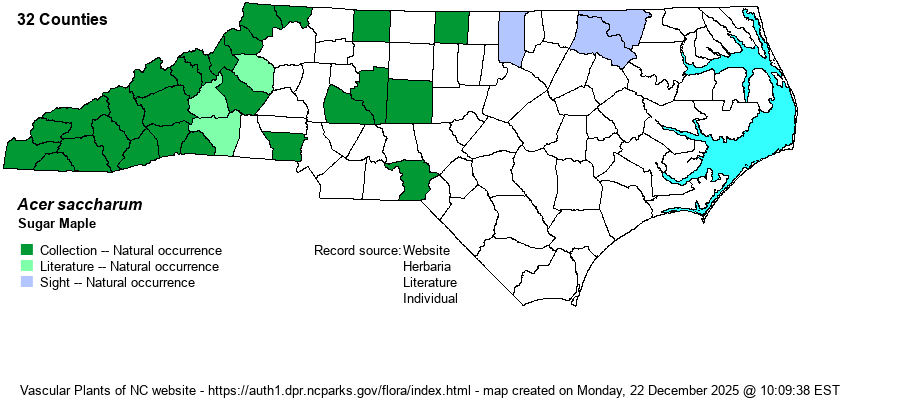| Author | Marshall | |
| Distribution | Throughout the Mountains, and widely scattered into the eastern Piedmont, though not found in many counties in that province. County specimen records were checked at UNC-CH herbarium in February 2019. A specimen from a mafic ridge in northwestern Richmond County was given to UNC-CH in 2021.
A Northern species, found from eastern Canada to AL and OK. Found in nearly all counties from PA to IL.
| |
| Abundance | Common and widespread in the Mountains, except in low elevations, where fairly common to common. Rare and somewhat poorly known in the Piedmont, where likely overlooked as Florida Maple (A. floridanum). Some Piedmont records likely relate to escaped individuals/populations. | |
| Habitat | This is one of the characteristic and dominant species of Rich Cove Forest and Northern Hardwood Forest natural communities, being a species of rich soils on slopes, for the most part. In the Piedmont, natural occurrences are in circumneutral soils of Basic Mesic Forest or on natural levees and other very rich bottomlands. In rich bottomlands and levees of mid and lower Piedmont, may occur with Florida Maple, but confirmation of this is lacking. |
| Phenology | Flowers from April to June, and fruits from June to September. | |
| Identification | Though a very well known species, especially to lovers of fall colors – a bright orange to scarlet color at its peak --on October drives along the Blue Ridge Parkway, it can be tricky to separate from Florida Maple downstate. This is a medium to large deciduous tree, often reaching 90 feet or more. Its opposite leaves typically have three main square-shaped lobes with parallel sides; but there is usually a lower triangular lobe on each side of the petiole. They are larger than most other maples, often 5-6 inches across and long; roughly twice the size of Florida Maple. Unlike some Florida Maple, Sugar Maple leaves are glabrous below, or have some hairs only along the veins (other Florida Maples are pubescent beneath). Also, Sugar Maple has gray-brown bark with some fissures; Florida Maple bark is mostly smooth and gray, with furrows only on quite old trees. | |
| Taxonomic Comments | Some references name a few varieties for it, though Weakley (2018) does not.
| |
| Other Common Name(s) | Rock Maple, Hard Maple, Sugar Tree | |
| State Rank | S5 | |
| Global Rank | G5 | |
| State Status | | |
| US Status | | |
| USACE-agcp | FACU link |
| USACE-emp | FACU link |

